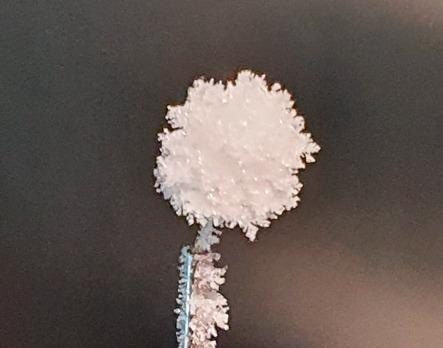When the low-pressure system known as Bernd decided to reside over a portion of Central Europe in the summer of 2021, the dangers of excessive rainfall were brought to light in the form of catastrophic flooding.
 A rimed ice particle, in this case a graupel pellet, created for experimental use in the Mainz vertical wind tunnel. Image Credit: © Alexander Theis
A rimed ice particle, in this case a graupel pellet, created for experimental use in the Mainz vertical wind tunnel. Image Credit: © Alexander Theis
Weather records gathered illustrate that extreme natural occurrences like drought, hail storms and heavy rainfall are likely to take place even more frequently in this part of the world due to climate change.
Also, their impacts could become highly destructive. For instance, hailstone could damage vehicles, crops and buildings and they could also be hazardous to humans and animals.
Hence, it is all the more significant that weather models have the ability to predict the chance and extent of any such precipitation more accurately. For this to happen, the numerical weather models must be based on accurately formulated mathematical interpretations of the physical processes happening in clouds.
The only one of its kind in the world, the vertical wind tunnel at Johannes Gutenberg University Mainz (JGU) offers significant data in this connection via new experiments that are being performed using artificial hailstones created by a 3D printer.
One thing we have learned so far is that it is the form of hailstones that determines their velocity prior to impact.
Dr. Miklós Szakáll, Institute of Atmospheric Physics, Johannes Gutenberg University Mainz
Szakáll’s group has been able to illustrate that lobed hailstones tend to develop less kinetic energy and hence harbors less destructive potential compared to hail with a smooth surface.
Hail and graupel, which is the term utilized to explain precipitated small, soft ice pellets are developed when water droplets freeze in storm clouds. This freezing process has been boosted by turbulences and complicated physical processes in such clouds that can go up to extremely high altitudes.
Such ice particles melt if they pass via warmer air layers while declining. The outcome is big, cold raindrops, and these are frequently considered the culprits behind extreme rainfall precipitation. The ice particles fall in the form of hail or graupel if they do not have time to melt completely prior to reaching the ground.
Experiments with Natural and Artificial Hailstones
The conditions inside clouds help identify the characteristic form, size and mass of such frozen droplets.
In our experiments with natural hailstones, we have seen that they melt to form raindrops that can be several millimeters in diameter. Large hailstones can also burst during the melting process, forming numerous small water droplets.
Dr. Miklós Szakáll, Institute of Atmospheric Physics, Johannes Gutenberg University Mainz
From the collected recorded measurements, Szakáll’s team was able to infer parameters that they could utilize as the primary elements for the numerical simulation of clouds and precipitation in computer models.
Hailstones and graupel particles were produced by the research team in Mainz, from frozen water in the laboratory. Applying realistic humidity and temperature conditions, the scientists closely observed how these melted or fell in the vertical wind tunnel.
They utilized a 3D printer to make artificial hail and graupel pellets that have been modeled on their natural counterparts – even the material density matched with that of ice. Furthermore, they utilized these to quantify the free fall properties of the sinking objects. These are factors appropriate to the microphysical processes in extreme precipitation events.
The graupel and hail pellets were freely suspended in an artificially produced vertical air stream in the 6 m high wind tunnel. Their behavior was registered with the help of high-speed and infrared cameras and a specifically developed holographic imaging system.
If we apply the insights into microphysical aspects of precipitation, we have obtained through these experiments to models used for the analysis of storm clouds, we can better anticipate what they will do.
Stephan Borrmann, Professor, Institute of Atmospheric Physics
Stephan Borrmann is also the director of the Max Planck Institute for Chemistry.
Borrmann. added, “This becomes particularly significant in view of the probable increase in extreme weather events, such as drought and torrential rainfall, that will occur even in our part of the world due to climate change.”
The experiments performed in Mainz were undertaken under the aegis of the HydroCOMET project that was sponsored by the German Research Foundation (DFG). The study outcomes have been reported in five peer-reviewed journals and as a book contribution.
The experts examining the HydroCOMET findings offered very positive evaluations of the laboratory experiments executed in Mainz and the associated publications. The researchers emphasized the significant role played by the available infrastructure — the vertical wind tunnel.
Journal Reference:
Theis, A., et al. (2021) Vertical wind tunnel experiments and a theoretical study on the microphysics of melting low-density graupel. Journal of the Atmospheric Sciences. doi.org/10.1175/JAS-D-21-0162.1.